Infrastructures between Markets and Government (and Technology)
On October 24th 2017 Prof. Matthias Finger from EPFL visited ISTP to talk about three diffrent ways that regulations are developed and the way that they can be sustainable in the long run using the examples of the US, World Bank and EU.
by Philippe Stadler Benz

Prof. Finger started his presentation with definitions and three different views on regulation – the static, the ideological and the historic view.
After this introduction, he focused on three regulatory systems: The US system is a bottom-up model in which everything is regulated at the state and not the federal level with elected utilities commissions in every state. The federal level only regulates the interfaces between the states. Although it is a relatively stable system, it cannot be exported.
In the World (Bank)-model, everything is regulated and specified by contracts. This is not a sustainable model, as for example governments are often not competent in signing such contracts.
He stated, that the EU-approach is the only solid model. It increases the competitiveness of the countries by unbundling economic regulation of monopolies from competition regulation. This creates EU-wide markets (for example one could buy electricity from Sweden and consume it in Germany) and a seamless EU-wide infrastructure (also known as Copper-Plate Europe in the electric market). Although not every company will survive (and the model has not the aim to privatize companies) in this market, the ones remaining will be much stronger.
In such a model, a harmonized EU-regulation is needed and national politics have to be overruled by EU-regulation. The regulators have to be independent from the companies and should be independent from politics. This could be applied in every sector, although some might be more advanced.
Prof. Finger pointed out, that there is a convergence of sectors. For example, electricity and gas industries are moving together, mobility becomes much more integrated or even the mobility- and the energy-sector merge. Therefore, a sector specific regulation might not be sustainable in the long run and might lead to a merger on the regulator side, too what already happened in Germany. With that, a lot of synergies could be used.
The hypothesis of Prof. Finger is, that the integrated company had some synergies, which are now split up artificially. This is why there is a lot of innovation in the interface between monopoly and competition, what blurs the separation and monopolies are re-emerging.
Digitalization creates even more of a monopoly as it accelerates the process of global companies. This raises the question of how to regulate this subject. Currently, digitalization is regulated in every sector although it would be transversal (access and availability to data, transparency, security, etc.). Another question is, how will infrastructures be financed in the future, if all the added value of data will go to the global companies.
On the dynamics model, Prof. Finger showed, that in the beginning an institutional change triggers innovation and ideologically, the market between the institutional and technological changes becomes bigger. Institutional changes mean that the rules are changed and there are technological changes in every industry.
Regulators originally regulated the price of the monopolistic networks (for example the price of electricity transport through the network) and the access to the network. Today, the field of regulators is much broader. They have to look at the entire systems, at scarce capacity, availability, stability and other not economic terms. But these technical decisions have economic consequences. Public service obligation, the quality and who should have access and environmental issues are other subjects.
Prof. Finger concluded, that the regulation system is not a stable model. It is continuous as regulators, technologies and markets will evolve. Therefore, it will stay an exciting interdisciplinary field and needs a lot of research in order that debates become objective.
To get a broadened sense of the ISTP and our topics of interest and past seminars visit our Colloquium page.